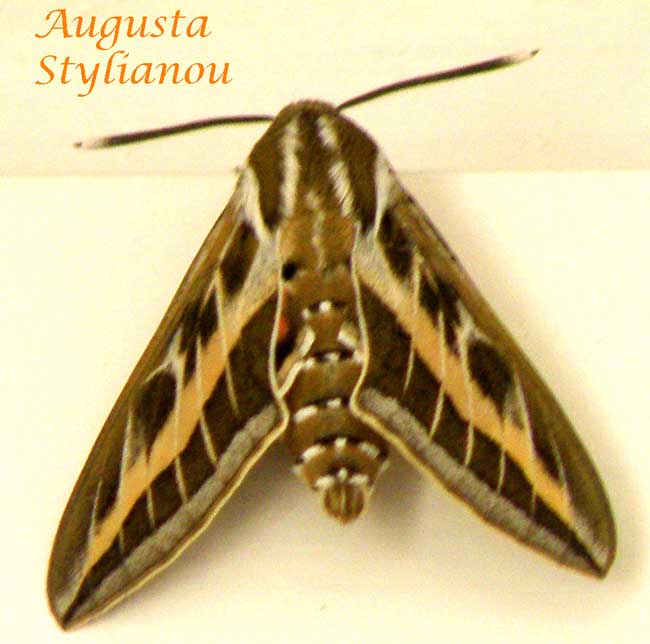
Hyles livornica, Germasogeia, Cyprus, Photo: Augusta Stylianou Artist
Superregnum: Eukaryota
Cladus: Unikonta
Cladus: Opisthokonta
Cladus: Holozoa
Regnum: Animalia
Subregnum: Eumetazoa
Cladus: Bilateria
Cladus: Nephrozoa
Cladus: Protostomia
Cladus: Ecdysozoa
Cladus: Panarthropoda
Phylum: Arthropoda
Subphylum: Hexapoda
Classis: Insecta
Cladus: Dicondylia
Subclassis: Pterygota
Cladus: Metapterygota
Infraclassis: Neoptera
Cladus: Eumetabola
Cladus: Endopterygota
Superordo: Panorpida
Cladus: Amphiesmenoptera
Ordo: Lepidoptera
Subordo: Glossata
Cladus: Coelolepida
Cladus: Myoglossata
Cladus: Neolepidoptera
Infraordo: Heteroneura
Cladus: Eulepidoptera
Cladus: Ditrysia
Cladus: Apoditrysia
Cladus: Obtectomera
Cladus: Macroheterocera
Superfamilia: Bombycoidea
Familia: Sphingidae
Subfamilia : Macroglossinae
Tribus: Macroglossini
Subtribus: Choerocampina
Genus: Hyles
Species: Hyles livornica
Hyles livornica, the striped hawk-moth, is a moth of the family Sphingidae.
Taxonomy and systematics
Eugenius Johann Christoph Esper described the striped hawk-moth in 1780 using a specimen found in Italy at Livorno (hence the Latin name livornica). In 1819 Jacob Hübner allocated this species in his newly erected genus Hyles.
Until the 20th century Hyles livornica has been considered conspecific with the American Hyles lineata and is therefore under that name (or as Celerio lineata ssp. livornica) found in the older literature. Similar was the case with the Hyles livornicoides, which is prevalent in Australia. Hyles renneri from Nepal is sometimes treated as a valid species.
On the basis of DNA testing it is well established that H. livornica in its entire Afro-Palaearctic distribution forms a genetic and taxonomic unit. This results in the following relationships among the Palaearctic widespread species of the genus Hyles:
Hyles nicaea
Hyles gallii
Hyles livornica
Hyles vespertilio
Hyles euphorbiae - Complex s.l.
Distribution
This species is found in Africa, southern Europe, Poland, Australia, and central and east Asia.[1][3]
Description
Hyles livornica has a wingspan reaching 60–80 mm. Males are slightly smaller than females. The forewings and the body are mainly olive brown or beige, with white stripes. The hindwings are pink, with black and white edges. The head and the thorax are olive-brown, with white stripes. The olive-brown abdomen has black-and-white segment, the first two segments have large black and white side spots. The antennae are dark olive brown and have a white tip.
These moths fly from February to October depending on the location. In Europe they are visible from April to June and from August to September in two generations and sometimes they overwinter. This species is a migrant from Africa to Europe. The caterpillars are green, with black markings and reach a length from 65 to 80 millimeters.
Male
Male
Female
Female
Biology
The caterpillars feed on various plants, mainly on Galium, Gossypium, Rumex, Vitis, Euphorbia, Linaria, Epilobium, Antirrhinum, Scabiosa, Linum, Fuchsia and Asphodelus.[3]
See also
Lepidoptera migration
Sphingidae
References
Fauna Europaea
Pittaway, A. R. (2018). "Hyles livornica (Esper, 1780)". Sphingidae of the Western Palaearctic. Retrieved December 17, 2018.
Savela, Markku. "Hyles livornica (Esper, 1780)". Lepidoptera and Some Other Life Forms. Retrieved November 23, 2018.
Retrieved from "http://en.wikipedia.org/"
All text is available under the terms of the GNU Free Documentation License

